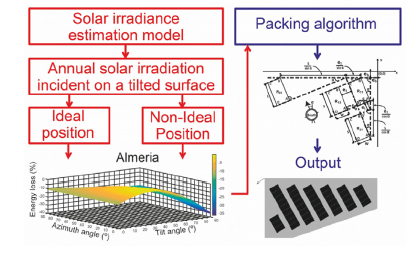In today’s world, sustainability is an undeniable priority. Photovoltaic systems play an essential role in this scenario, but often, achieving ideal tilt and orientation conditions is challenging in urban applications. Recent research from the research group with which our team has collaborated alongside the University of Oviedo has revealed how to optimize photovoltaic energy generation in non-ideal positions, opening new opportunities for renewable energy in our cities.
Energy Loss Analysis
The study, titled “Analysis of Tilt and Azimuth Angles of Photovoltaic Systems in Non-Ideal Positions for Urban Applications,” focuses on two key aspects. Firstly, it evaluates the energy losses resulting from deviations in the tilt angle (?) and orientation (?) of photovoltaic installations compared to the ideal position. Using the Cavaleri principle and considering local cloudy sky conditions, the study examined ten cities in the Northern Hemisphere. Surprisingly, it was found that non-ideal tilt and azimuth angles can still result in acceptable levels of electricity generation.
For instance, a south-facing photovoltaic system (? = 0°) with deviations of up to 10 degrees (◦) from the optimal tilt angle had a minimal influence on energy losses, ranging between 5% and 20% for larger deviations.
Urban Roofs: Maximizing Efficiency
The second part of the study addresses a crucial practical application. It explores the optimal distribution of photovoltaic modules on flat roofs with irregular shapes of urban buildings, aiming to maximize energy generation. This complex engineering problem involves numerous variables, such as roof area, shape, module dimensions, positioning, and more. The study’s goal is to provide assistance in decision-making in this intricate context.
The research introduces a packaging algorithm developed in Mathematica™ that takes into account shading and maintenance distances to maximize the energy generation area of photovoltaic systems on these special roofs.
Influence of Tilt Angle on Energy Generation
Essentially, the study highlights the influence of ? on the potential capacity of photovoltaic systems. Surprisingly, a decrease in the optimal tilt angle can lead to a substantial increase in energy generation. For example, in AlmerÃa, a 24% increase in energy production was observed when the tilt angle decreased from 30.3 (â—¦) to 14 (â—¦).
Answers to Practical Questions
These findings have significant implications for practical decision-making in the installation of photovoltaic systems in urban environments. They address critical questions: How many photovoltaic modules are required? What is the optimal position for these modules? What is the orientation that will yield the best results? Now, installers and stakeholders in the photovoltaic industry have access to valuable information that can drive more efficient and sustainable energy solutions in urban settings.
This study paves the way for innovation in the integration of renewable energy in urban areas, offering a new perspective on the potential of photovoltaic systems, even in non-ideal conditions.
